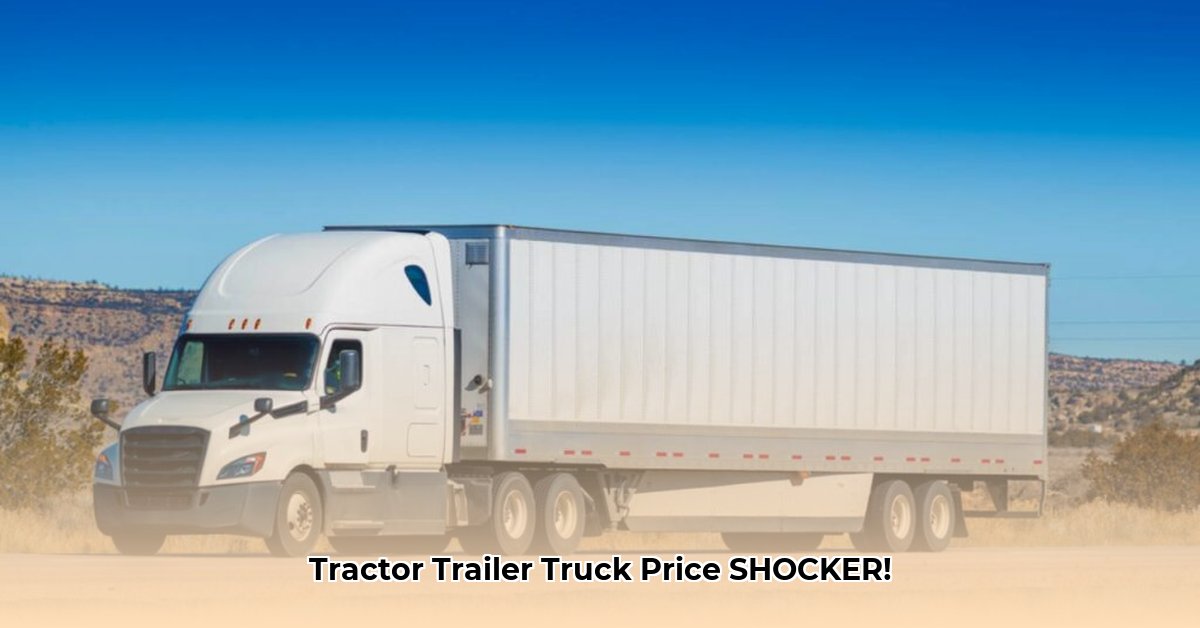
Understanding the Total Cost of Ownership (TCO)
Purchasing a tractor-trailer truck is a significant investment. Determining the true cost goes far beyond the sticker price. This guide provides a comprehensive breakdown of the Total Cost of Ownership (TCO), helping trucking businesses make informed decisions in 2024. The TCO encompasses various factors, influencing the final cost of owning a semi-truck. It's crucial to understand these components to make a financially sound choice. Do you understand the hidden costs involved in owning a big rig? For more information on truck weight, see this helpful resource.
New vs. Used Trucks: A Price Comparison
The initial cost varies drastically depending on whether you opt for a new or used truck. New semi-trucks range from $75,000 to over $200,000, depending on features and engine power. Used trucks offer a more affordable entry point, typically costing between $10,000 and $140,000. However, a pre-purchase inspection is essential to avoid unexpected repairs. Considering the significant price difference, which option aligns with your budget and risk tolerance?
Financing Options: Buying, Leasing, or Renting
Financing choices influence your TCO dramatically. Three primary options exist:
Buying: Offers full ownership and long-term control but demands substantial upfront capital. You bear responsibility for all maintenance and repairs.
Leasing: Reduces the initial financial burden with monthly payments typically ranging from $1,000 to $2,500. However, you're bound by a contract for a specific term.
Renting: Ideal for short-term needs, costing approximately $170 to $215 per day. This option provides maximum flexibility but is the most expensive per day.
The optimal choice depends on your business's size and long-term strategy. Small businesses might find leasing or renting more suitable initially. Established fleets might find purchasing more cost-effective in the long run.
Calculating the TCO: A Step-by-Step Approach
Calculating the total cost of ownership requires a structured approach. Here's a six-step process:
Gather Data: Compile information on acquisition cost, financing terms (interest rates, loan duration, lease payments), projected mileage, fuel prices (consider current market volatility), anticipated maintenance and repair costs, insurance premiums, and the estimated resale value. Thorough research is essential for accurate estimations.
Estimate Annual Operating Costs: Calculate annual fuel consumption based on estimated mileage and current fuel prices. Estimate annual maintenance, repair, insurance, licensing, and tire replacement costs. Remember that regular preventative maintenance can substantially reduce repair expenses. Consider fuel efficiency in your decision-making.
Project Costs Over Time: Project your total costs over the truck's estimated lifespan (typically 5-7 years). This involves multiplying your annual costs by the number of years of operation.
Include Financing Costs: Add your total financing costs (interest or lease payments) over the same timeframe to your projected operational costs.
Subtract the Disposal Value: Subtract your estimated resale value from the total cost over the truck's life. This value is important for long-term cost analysis.
Determine the Net TCO: The resulting figure represents your truck's net TCO. This provides a clear picture of the total financial commitment associated with your semi-truck.
Key Factors Influencing TCO: Beyond the Obvious
Several hidden costs significantly impact your TCO:
Fuel Costs: Fluctuating fuel prices are a major expense. Choosing a fuel-efficient model is crucial for cost control.
Maintenance and Repairs: Regular maintenance is essential. Preventive maintenance minimizes unexpected breakdowns and expensive repairs. Budget for both routine servicing and unforeseen repairs.
Permits and Regulations: Factor in permit fees (like the Heavy Vehicle Use Tax) and state-specific licensing costs. These add up quickly. Staying current on changing regulations is paramount.
Insurance: Comprehensive insurance is non-negotiable. Secure adequate coverage to protect your significant investment.
Risk Mitigation Strategies: Protecting Your Investment
Purchasing a semi-truck inherently involves risks. Here's a risk mitigation strategy:
| Risk Factor | Mitigation Strategy |
|---|---|
| Unexpected Repairs | Comprehensive pre-purchase inspection; regular maintenance. |
| Fuel Price Fluctuations | Fuel-efficient truck; consider alternative fuels. |
| Market Value Depreciation | Thorough research; consider resale value when purchasing. |
| Regulatory Changes | Stay informed about regulations and plan for compliance. |
By proactively implementing these mitigation strategies, trucking businesses can significantly reduce the impact of unexpected expenses and maintain financial stability. Careful planning and regular monitoring are key to managing risks effectively.
"A thorough TCO analysis is critical for long-term success in the trucking industry," says Dr. Emily Carter, Professor of Transportation Economics at the University of Transport Logistics. "Understanding the complete cost picture enables informed decision-making, enhancing profitability and stability."
This comprehensive guide provides a clear path to calculating and understanding the total cost of ownership of a tractor-trailer truck. By following these steps, you can make an informed decision that aligns with your business objectives and financial capabilities. Remember to always stay informed about industry trends and evolving regulations to optimize your long-term strategy.